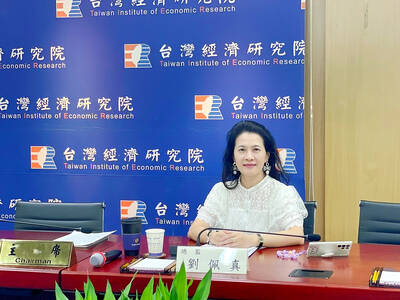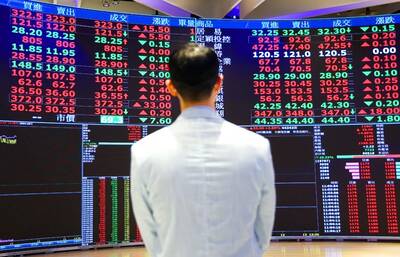Ahead of the release of last month’s unemployment figures today, pundits predicted the jobless rate may hit a record high and rise in the coming months, despite the recent announcement of a consumer voucher plan and other stimulus measures by the government.
Ryan Wu (吳睿穎), chief operating officer at 1111 Job Bank (1111人力銀行), said he expected last month’s unemployment rate to be 4.4 percent as more businesses cut costs or exited the market amid the global economic downturn.
“The unemployment rate is likely to hit 4.4 percent and is bound to climb higher in the months ahead,” Wu said by telephone. “I see no reason for optimism in light of the drab economic outlook.”
Unemployment reached a four-year high of 4.27 percent in September, up 0.13 percentage points from a month earlier, defying a seasonal drop normally seen at the end of summer, the Directorate General of Budget, Accounting and Statistics (DGBAS) said. The seasonally adjusted jobless index gained 0.19 percentage points to 4.12 percent — also the highest in four years — prompting the agency to sound the alarm for an ominous structural change in the labor market.
On Thursday, the DGBAS raised the specter of recession by reporting the nation’s GDP contracted 1.02 percent in the third quarter and may decline another 1.73 percent and 0.3 percent in the final quarter and first three months of next year respectively.
Wu said most newly laid off people were middle-aged or older, while young college graduates continued to top the unemployment list.
“Falling profit margins have led companies to lay off senior employees whose wages are relatively higher,” Wu said. “The trend promises no opportunity for young jobseekers, as companies are trying hard to survive and have no appetite for new staffers.”
Exports, the mainstay of the nation’s economic growth, are expected to drop 8.28 percent in the fourth quarter, after gaining 18.07 percent in the first half and 8.05 percent in the third quarter, the DGBAS said last week.
Shrinking export orders have caused the private sector to tighten its belt, with private investment expected to drop 11.4 percent in the last quarter, putting the annual figure at minus 2.87 percent this year, the agency said.
Unlike their counterparts in the US and Europe, Taiwanese employers tend to retain glut workers until the Lunar New Year out of sympathy, Wu said, making it premature to speculate on when the jobless rate will peak.
Economists at Citigroup Taiwan shared the gloomy sentiment and predicted in a client note on Friday that the seasonally adjusted unemployment rate for last month would reach 4.2 percent, the highest level since April 2005.
Cheng Cheng-mount (鄭貞茂) and Tina Liao, who coauthored the client note, attributed the rising jobless rate to weaker domestic demand and deteriorating exports.
Norman Yin (殷乃平), a money and banking professor at National Chengchih University, said the voucher plan and other stimulus measures would provide some short-term relief, but were not strong enough to reverse the economic downturn.
“Attempts to expand domestic demand will prove evasive,” Yin said by telephone. “The manufacturing industries are bound to suffer amid the global economic recession. The government cannot avert the scenario without ridding the nation of its dependence on exports.”
Yin said the government was overoptimistic in predicting the economy will start to recover in the second quarter of next year, adding that the impact of the financial crisis would last for at least a year or two.

IN THE AIR: While most companies said they were committed to North American operations, some added that production and costs would depend on the outcome of a US trade probe Leading local contract electronics makers Wistron Corp (緯創), Quanta Computer Inc (廣達), Inventec Corp (英業達) and Compal Electronics Inc (仁寶) are to maintain their North American expansion plans, despite Washington’s 20 percent tariff on Taiwanese goods. Wistron said it has long maintained a presence in the US, while distributing production across Taiwan, North America, Southeast Asia and Europe. The company is in talks with customers to align capacity with their site preferences, a company official told the Taipei Times by telephone on Friday. The company is still in talks with clients over who would bear the tariff costs, with the outcome pending further

A proposed 100 percent tariff on chip imports announced by US President Donald Trump could shift more of Taiwan’s semiconductor production overseas, a Taiwan Institute of Economic Research (TIER) researcher said yesterday. Trump’s tariff policy will accelerate the global semiconductor industry’s pace to establish roots in the US, leading to higher supply chain costs and ultimately raising prices of consumer electronics and creating uncertainty for future market demand, Arisa Liu (劉佩真) at the institute’s Taiwan Industry Economics Database said in a telephone interview. Trump’s move signals his intention to "restore the glory of the US semiconductor industry," Liu noted, saying that

NEGOTIATIONS: Semiconductors play an outsized role in Taiwan’s industrial and economic development and are a major driver of the Taiwan-US trade imbalance With US President Donald Trump threatening to impose tariffs on semiconductors, Taiwan is expected to face a significant challenge, as information and communications technology (ICT) products account for more than 70 percent of its exports to the US, Chung-Hua Institution for Economic Research (CIER, 中華經濟研究院) president Lien Hsien-ming (連賢明) said on Friday. Compared with other countries, semiconductors play a disproportionately large role in Taiwan’s industrial and economic development, Lien said. As the sixth-largest contributor to the US trade deficit, Taiwan recorded a US$73.9 billion trade surplus with the US last year — up from US$47.8 billion in 2023 — driven by strong

STILL UNCLEAR: Several aspects of the policy still need to be clarified, such as whether the exemptions would expand to related products, PwC Taiwan warned The TAIEX surged yesterday, led by gains in Taiwan Semiconductor Manufacturing Co (TSMC, 台積電), after US President Donald Trump announced a sweeping 100 percent tariff on imported semiconductors — while exempting companies operating or building plants in the US, which includes TSMC. The benchmark index jumped 556.41 points, or 2.37 percent, to close at 24,003.77, breaching the 24,000-point level and hitting its highest close this year, Taiwan Stock Exchange (TWSE) data showed. TSMC rose NT$55, or 4.89 percent, to close at a record NT$1,180, as the company is already investing heavily in a multibillion-dollar plant in Arizona that led investors to assume